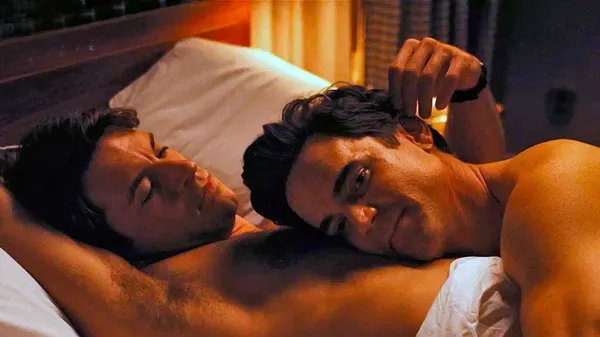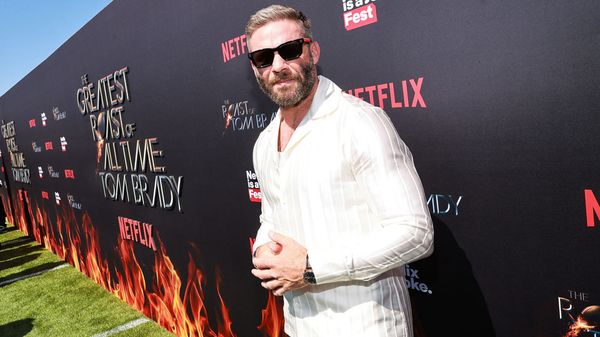
March 28, 2023
With 'Up with the Sun' Novelist Thomas Mallon Offers Dishy Showbiz Mash-up
Kilian Melloy READ TIME: 9 MIN.
In "Up with the Sun," out novelist Thomas Mallon mixes real-life people with entirely fictitious characters to tell the story of Dick Kallman, an actor striving toward what he believes will be predestined greatness on stage and film in the 1950s and '60s.
Thomas Mallon's novels tend toward the political, which is perhaps no surprise since Mallon, in addition to being a well-regarded novelist and essayist, has also been a luminary on the right, serving as the Deputy Chairman of the National Endowment for the Humanities under the George W. Bush administration. His acumen has allowed Mallon to pierce history and politics alike with an incisive sense of the absurd, which he couples with a sense for history and historical detail.
For his latest, "Up with the Sun," Mallon swaps politics for showbiz, mixing, as he often has, fictionalized versions of real-life people with entirely fictitious characters to tell the story of Dick Kallman, an actor striving toward what he believes will be predestined greatness on stage and film in the 1950s and '60s. Telling the story in first-person from the opposite end of history is Broadway pianist Matt Liannetto, who, together with a group of other men, meets with Kallman and his younger boyfriend on the very evening in 1980 they are murdered. Prior to the crime, Kallman presses a lapel pin into Liannetto's hand – a prop, Liannetto believes, that comes from a play the two of them worked when they met decades earlier. As the criminal investigation into the killings proceeds, Liannetto finds himself drawn close to some of the drama's central players, including Kallman's business partner (and fading showbiz star in her own right) Dolores Gray and a sexy police operative named Devin.

What the novel slowly reveals is how Kallman's lifelong obsession with fellow gay actor Kenny Nelson (also a fictionalized version of a real person) ties in with his sputtering career, and what part the prop pin he once pressed into Kenny's hand plays in his tragic end. Sprinkled throughout the book are showbiz legends like Kaye Ballard, Sophie Tucker, Dyan Cannon, and even Johnny Carson, but it's Kallman's impenetrable presence that resounds across time and excites Liannetto's interest in finding out the truth behind February 22, 1980 – the night Kallman was killed.
EDGE caught up with Thomas Mallon to discuss his fascination with history and historical figures, and to chat about how another Mallon novel, "Fellow Travelers," is being adapted into a Showtime miniseries, with Matt Bomer playing Hawkins Fuller and Jonathan Bailey playing Tim Laughlin – two gay civil servants (entirely fictitious, in this case) caught up in the frenzies of Joe McCarthy's "pink scare."

EDGE: You mentioned in a previous interview that when you were writing "Fellow Travelers," you felt in a way you were transposing your own life to an earlier time. I wonder if an element of that also figures into "Up with the Sun?"
Thomas Mallon: I think that there are probably bits and pieces of me in Matt Liannetto. I find myself seeking through him, and to some extent even feeling through him. I don't identify with Kallman at all.
With Timothy and "Fellow Travelers," it was very conscious on my part that I was setting out to imagine what my life might have been had I been born 20 years earlier. The first note I made for that novel, as I remember it, was "Timothy Lawson, born November to 1931," which would have been 20 years to the day prior to the day I was actually born.
EDGE: I was expecting Matt Liannetto to become some sort of amateur sleuth, but you let him perch on the sidelines and witness the unfolding of the mystery.
Thomas Mallon: Yes, and he doesn't really do any sleuthing, once he gets involved with Devin, who is doing a bit of sleuthing on behalf of the police department. Matt is kind of hearing about [the criminal investigation] from Devin.
Devin was supposed to come and go in the space of a paragraph or two, and I had conceived Matt as kind of a Nick Carraway narrator who would simply be concentrating on his memories of Kallman. But even though I've always been wary of the idea that characters take on a life of their own, at this late point in life and having written so many books, I began to experience that. Once Devin made an appearance and was sort of fun, he took up residence in my mind and I decided, "Well, why not? Why not actually give Matt a little bit more of a life than you had planned on giving him?" The Matt/Devin romance becomes the really nice thing in the book in which most of the action that has to do with Kallman is anything but nice. Matt is a safe harbor for the reader, in a way.

EDGE: No, Kallman is not nice, yet you explore him in a way that lets us understand the character a little bit better.
Thomas Mallon: The essential condition for writing a novel is empathy – putting yourself in the character's circumstances, imagining what the character that goes through. In "Fellow Travelers," Hawkins Fuller, who's the kind of homme fatale, he's got these spectacular good looks, and this educational pedigree, and this WASP-y ethnic pedigree, he clearly exercises power over Timothy – and, toward the end of the book, is guilty of a terrible betrayal of him. And yet, I never saw him as a villain. The opera that the book was made into doesn't see him that way, and I suspect that the television series that's coming doesn't see him that way, either, because he's a victim in his own way.
EDGE: I'm interested to in how you choose to fictionalize real people in your books. Wouldn't it be easier just to write completely fictional people? Or is it more fun to take real people and put them in semi-imaginary situations?
Thomas Mallon: Well, it's, it's more fun if they're dead and gone. [Laughter] You can't really do it with living people, but a lot of my books have the sort of template [in which] invented characters wind up almost accidentally playing a minor role in history. That seems to appeal to me quite a bit. [My novels] may have a lot of accurate history in them, but in the end they remain novels.
EDGE: "Fellow Travelers" not only is going to be a miniseries on Showtime, but also was made into an opera. What do you feel is the allure for that particular story out of all your books, that it's been given these couple of adaptations?
Thomas Mallon: I think the very things that would have precluded such adaptations of that novel years ago now motivate the adaptations. There's this great hunger among gay people to see the stories of their own history, and there's a much greater openness amongst straight people to hear these stories.
The fellows who put [the opera] together are much younger than myself. I knew nothing about opera, which I think was a great boon to them, because I had no inclination to look over their shoulder and get involved. It's the same thing with Showtime. I've never been up to the set. I haven't met the actors. I haven't seen a script. I'm completely amused that the character who was loosely based on me, this sort of slightly built, bespectacled, Irish American boy who stammers and is shy – well, of course, who else [plays that role] but "Bridgerton"'s Jonathan Bailey! [Laughter]

EDGE: What do you have coming up in the future?
Thomas Mallon: It appears as if I'm gonna do a whole volume of diaries that a selection from them ran in The New Yorker just before Christmas. I've kept diaries for most of my life, but these were the diaries from the mid- to late 1980s, when I was living in New York during the first years of the AIDS epidemic. I was struck when I went back to [the diaries], how manic they were. I loved being in New York. I was getting a late start as a writer; I was thrilled whenever I was making progress. And then, the next day, I would just crash land because there'd be some horrible bit of AIDS news, or a friend of mine was sick. There were tremendous ups and downs.
When I was talking with editors of the magazine about them, there was some talk about, "Well, maybe this would work better as a retrospective essay about the time, and you could quote from the diaries." I resisted that. I thought if the diaries have any real value, it's in their immediacy, having the diarist write without any knowledge of what's happening in the future. One of the principal moods of the diaries was dread, constant dread. Ultimately, that approach prevailed.
I'm looking forward to doing it. I mean, I've kept these [diaries] for years and years and years. I never knew exactly what I was going to do with them – and I think this is going to be it.
"Up with the Sun" is available now from Penguin Random House.
Kilian Melloy serves as EDGE Media Network's Associate Arts Editor and Staff Contributor. His professional memberships include the National Lesbian & Gay Journalists Association, the Boston Online Film Critics Association, The Gay and Lesbian Entertainment Critics Association, and the Boston Theater Critics Association's Elliot Norton Awards Committee.







